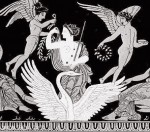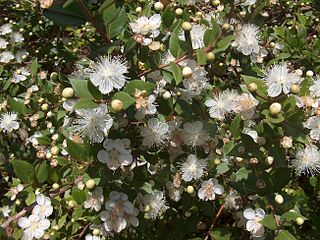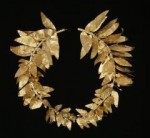Aphrodite and the Myrtle Tree
Our tree this week is the myrtle, sacred to Aphrodite. Myrtle trees were planted in Aphrodite’s temple gardens and shrines, and she is often depicted with a myrtle crown, sprig or wreath. Most people are familiar with Aphrodite as the Greek goddess of love, beauty and sex. Aphrodite is guardian of the gates of birth and death, symbolized by the vagina. As poets well know, myrtle rhymes with girdle, and Aphrodite has a very famous and coveted girdle that she sometimes lends to other goddesses. This is not the modern girdle that restricts breathing; this is a belt tied around the waist that makes the wearer sexually irresistible.Aphrodite’s myrtle is the Common Myrtle, a small, leafy evergreen native to Asia minor and southern Europe that grows well in dry, slightly alkaline soil. It is not closely related to the Crêpe Myrtle, a tree native to India that was planted in the Carolinas and escaped into the wild, nor is it related to the Honey Myrtle or Lemon Myrtle, both of Australia, which are becoming increasingly important in herbal medicine.With any tree sacred to a goddess it is important to examine whether it has a special relationship to the bee. Bees were highly regarded by ancient peoples, not only because they provide honey and pollination, but because like humans they live in highly organized communities. Goddesses of love and beauty are likely to be linked with bees, and Aphrodite is no exception. Aphrodite’s myrtle nymphs raised the God Aesacus, god of beekeeping and other cottage industries like olive curing and cheesemaking. Bees flock to the myrtle tree, and as a late blooming tree it is important in honey production. Pollen collected in the spring is used for the hive’s immediate needs, while pollen collected late in the year becomes surplus honey for the dormant period. A portion of this honey is harvested by the beekeeper. Myrtle honey, once important for food and medicinal uses, is an uncommon commercial honey today.You would expect the flowers of the myrtle to be odoriferous, considering its attractiveness to bees, but the leaves and the bark are also highly fragrant. The tree was used in ancient times to make perfume. The leaves and the ripe berries have a strong taste, reportedly similar to allspice, and they were used as a seasoning. This is significant because Aphrodite – like that other love god, Krishna – disapproves of garlic, and other seasonings must be substituted to flavor dishes at her festivals.The myrtle’s association with Aphrodite made sprigs an important component in bridal bouquets in Victorian times. In some Ukrainian weddings, myrtle wreaths are held above the heads of the bride and groom. In Greece myrtle boughs were used in funerary ceremonies, and the myrtle wreath had a place in the Eleusinian rites, which were an exploration of the mysteries of death and rebirth.Varieties of myrtle are usually planted as ornamental trees and shrubs, prized for their attractiveness and fragrance. The Common Myrtle is seldom used medicinally today, but classical texts indicate that it was once a standard treatment for a number of conditions. Myrtle is no longer a popular girls’ name, but it was well favored in the 1800’s, probably by mothers with a romantic nature. Apparently parents abandoned the name because the Myrtle girls were subjected to too much rhyming. (Fertile Myrtle has a turtle; jumps the hurdle in her girdle.)Though the myrtle is not the popular tree it once was, any well-stocked occult store will carry the essential oil or the leaf. Be sure not to confuse true myrtle (Myrtus communis) with oil of Honey Myrtle or Lemon Myrtle, which are different trees. SourcesGraves, Robert. The Greek Myths. London: Penquin Books, 1960.Plants for a Future. Myrtus communis – L.Powell, Cornelia. Queen Victoria’s Wedding Bouquet and the Legend of the Royal Myrtles.Theoi. Flora 2: Plants of Greek Myth.Weddings at Soyuzivka. Ukrainian Wedding Traditions.
SourcesGraves, Robert. The Greek Myths. London: Penquin Books, 1960.Plants for a Future. Myrtus communis – L.Powell, Cornelia. Queen Victoria’s Wedding Bouquet and the Legend of the Royal Myrtles.Theoi. Flora 2: Plants of Greek Myth.Weddings at Soyuzivka. Ukrainian Wedding Traditions.

Aphrodite riding goose, with son Eros holding myrtle wreaths. Date unknown. (Click on thumbnail for larger picture.)



Pingback:The Hard Side of Aphrodite | Hearth Moon Rising's blog